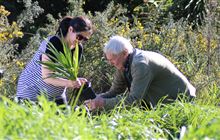A national Outcome Monitoring Framework for biodiversity (OMF)
Introduction
We’ve worked with an interagency group to develop a shared Outcome Monitoring Framework (OMF).It helps us track Te Mana o te Taiao – Aotearoa New Zealand Biodiversity Strategy 2020 (ANZBS) objectives and outcomes. The OMF represents a significant step in how New Zealand can best monitor and report on biodiversity.
ANZBS forms part of New Zealand's response to the United Nations Convention on Biological Diversity (UNCBD). Countries must report every 4 years on their progress. We have mapped UNCBD targets and indicators onto the OMF.
The OMF work has drawn on existing frameworks and delivers ANZBS goals 4.1 and 4.2 to:
- create a national set of indicators and common data standards
- ensure cross-agency alignment in national monitoring and reporting
- support decision making and inform progress towards outcomes of ANZBS.
The framework could also be used to support recommendations from the Parliamentary Commissioner of the Environment report. ‘Environmental Reporting and Monitoring: Do we know if we’re making a difference’. Framework indicators and measures are often identical to those used in national environmental reporting.
Working together
The government used a multi-agency co-development approach. This was to streamline ongoing central and regional government collaboration. There have been many workshops since November 2021, with a reference group established in 2022.
The interagency group is made up of:
- Department of Conservation – Te Papa Atawhai
- Ministry for the Environment – Manatū Mō Te Taiao
- Ministry for Primary Industries – Manatū Ahu Matua
- Land Information New Zealand – Toitū Te Whenua
- Statistics NZ – Tatauranga Aotearoa
- Regional and Unitary Councils Aotearoa – Te Uru Kahika.
The co-development process is led by external facilitators to ensure it is agency agnostic and follows international best practice.
The reports below document key milestone engagements, collective discussions and design decisions.
- Interagency alignment workshop proceedings report - March 2022 (PDF, 3,008K)
- Monitoring and reporting synthesis report - May 2022 (PDF, 4,072K)
- Interagency OMF proceedings report - March 2024 (PDF, 11,900K)
The discovery and define stages explored interdependent core work across agencies. This outlined monitoring and reporting requirements, indicators and measures in common. Through this process we discovered gaps in the framework where support is needed.
Resources
Outcomes Monitoring Framework database
We’ve created a database that allows you to explore how the framework connects across regional and central government work.
Glossary
We’ve developed a monitoring and reporting glossary to give you context to its structure and components.
View the monitoring and reporting glossary (PDF, 166K)
Assessment templates
We are revising priority assessment templates to align with the updated framework. These templates will describe the measures for each indicator including:
- scale
- measurement
- data sources.
They provide an evaluation against international criteria for assessing what makes a “good" indicator. These templates will be made available here at a later date.
Implementing the Outcome Monitoring Framework
The framework and database lay the groundwork for collective design and implementation of other monitoring programmes. The following DOC led project and programmes actively design and implement the framework.
- Tier 1 national monitoring programme
- Wild Animal Management Programme
- Marine monitoring and reporting framework
- Revitalising the Gulf Monitoring Framework development
Next steps
To continue building all of government collaboration and alignment, we’re investigating new pilots and proofs of concept. This will allow the framework to be stress-tested and provide data and recommendations for ongoing investment.
The goal is to address the three pou (pillars) of the ANZBS to create transformational change for biodiversity in New Zealand.
The three pou are:
- Tiaki me te Whakahaumanu: Protecting and restoring
- Whakahau: Empowering action
- Tūāpapa: Getting the system right.
Find out more about the Te Mana o te Taiao Aotearoa New Zealand Biodiversity Strategy.




